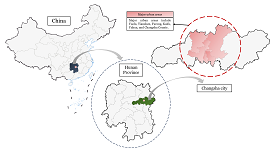
Asia Pacific Academy of Science Pte. Ltd. (APACSCI) specializes in international journal publishing. APACSCI adopts the open access publishing model and provides an important communication bridge for academic groups whose interest fields include engineering, technology, medicine, computer, mathematics, agriculture and forestry, and environment.

As China's pillar industry, the property market has suffered a considerable impact in recent years, with a decline in turnover and many developers at risk of bankruptcy. As one of the most concerned factors for stakeholders, housing prices need to be predicted more objectively and accurately to minimize decision-making errors by developers and consumers. Many prediction models in recent years have been unfriendly to consumers due to technical difficulties, high data demand, and varying factors affecting house prices in different regions. A uniform model across the country cannot capture local differences accurately, so this study compares and analyses the fitting effects of multiple machine learning models using February 2024 new building data in Changsha as an example, aiming to provide consumers with a simple and practical reference for prediction methods. The modeling exploration applies several regression techniques based on machine learning algorithms, such as Stepwise regression, Robust regression, Lasso regression, Ridge regression, Ordinary Least Squares (OLS) regression, Extreme Gradient Boosted regression (XGBoost), and Random Forest (RF) regression. These algorithms are used to construct forecasting models, and the best-performing model is selected by conducting a comparative analysis of the forecasting errors obtained between these models. The research found that machine learning is a practical approach to property price prediction, with least squares regression and Lasso regression providing relatively more convincing results.
The impact of cultural diversity on urban housing prices in China
Vol 3, Issue 1, 2022
Download PDF
Abstract
Using the commercial housing price data of 254 cities at prefecture level and above in China, this paper measures the cultural diversity by the diversity of Chinese dialects, and studies the impact of regional culture represented by dialects on urban housing prices. The research shows that after controlling the economic development level of the city, the urban ecological environment and other factors, the cultural diversity measured by dialect types has a significant negative impact on the price of urban commercial housing, that is, the more diverse the culture, the lower the house price, and the cultural diversity will restrain the house price by hindering the inflow of local population.
Keywords
References
- Lu M, Zhang H, Liang W. How the land supply biased towards the Midwest pushed up the wages in the East. Chinese Social Sciences. 2015; 5: 59–83.
- Bakens J, Mulder P, Nijkamp P. Economic impacts of cultural diversity in the netherlands: productivity, utility, and sorting. Journal of Regional Science. 2013; 53(1): 8–36. doi: 10.1111/jors.12012
- Elena B, Gianmarco OIP, Dino P, Giovanni P. Cultural diversity and economic performance: evidence from European regions. Econstor. 2008.
- Crescenzi R, Percoco M. Geography, institutions and regional economic performance. Berlin and Heidelberg: Springer; 2013.
- Ottaviano GIP, Peri G. The economic value of cultural diversity: evidence from US cities. Journal of Economic Geography. 2005; 6(1): 9–44. doi: 10.1093/jeg/lbi002
- Huang S. The contradiction between transaction cost saving and the diversified needs of national languages and its solution. Tianjin Social Sciences. 2015; 1: 132–135.
- Alesina A, Ferrara EL. Ethnic Diversity and Economic Performance. Journal of Economic Literature. 2005; 43(3): 762 –800. doi: 10.1257/002205105774431243
- Zak PJ, Knack S. Trust and Growth. The Economic Journal. 2001; 111(470): 295 –321. doi: 10.1111/1468-0297.00609
- El-Attar M, Poschke M. Trust and the Choice Between Housing and Financial Assets: Evidence from Spanish Households*. Review of Finance. 2011; 15(4): 727–756. doi: 10.1093/rof/rfq030
- Guiso L, Sapienza P, Zingales L. Trusting the Stock Market. The Journal of Finance. 2008; 63(6): 2557–2600. doi: 10.1111/j.1540-6261.2008.01408.x
- Dai Y, Xiao J, Pan Y. Can "local accent" reduce the agency cost of the company-Research Based on dialect perspective. Economic research. 2016; 51(12): 147–186.
- Chen Z, Lu M, Xu L. Returns to dialect. China Economic Review. 2014; 30: 27 –43. doi: 10.1016/j.chieco.2014.05.006
- You R, Zhou Z. Dialect and Chinese culture. Journal of Fudan University (Social science edition). 1985; 3: 232–237.
- Gao X, Long X. Will the cultural division caused by provincial administrative divisions affect the regional economy. Economics (quarterly). 2016; 15(2): 647–674.
- Pan Y, Xiao J, Dai Y. Cultural diversity and enterprise innovation: a study from the perspective of dialect. Financial research. 2017; 10: 146–161.
- Xu X, Liu Y, Xiao Z. Dialect and economic growth. Journal of economics. 2015; 2(2): 1–32.
- Lu M, Ou H, Chen B. Rationality or foam: An Empirical Study on urbanization, immigration and housing prices. World economy. 2014; 37(1): 30–54.
Supporting Agencies
Copyright (c) 2022 Yun Zhuang, Wenwen Wang

This work is licensed under a Creative Commons Attribution-NonCommercial 4.0 International License.

This site is licensed under a Creative Commons Attribution 4.0 International License (CC BY 4.0).

Prof. Mehmet Cetin
Kastamonu University,
Turkey
Polish Scientific Bibliography

